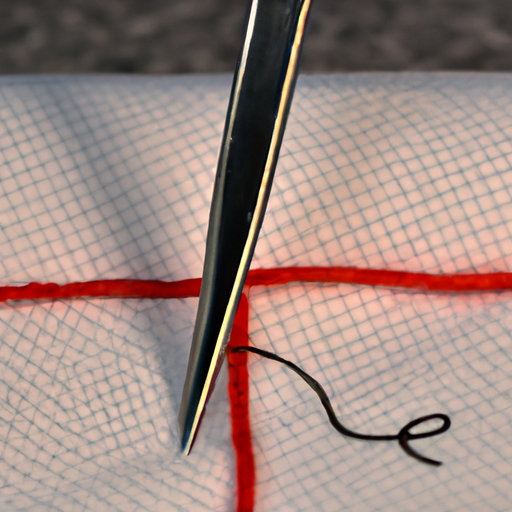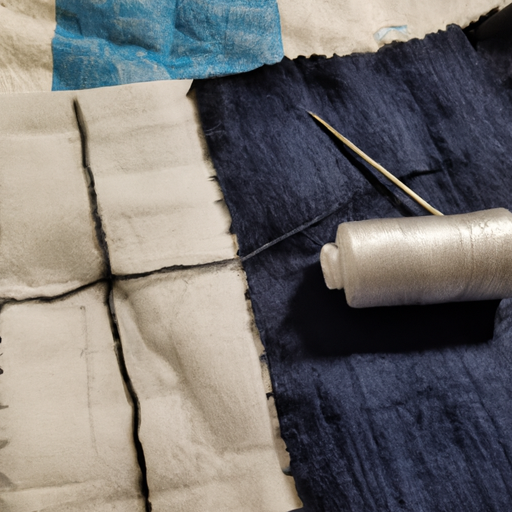
Can you quilt with a regular sewing thread?
The fabric is spread out before you, crisp and clean, ready to be transformed into a quilt. You have an image in your mind of what the finished masterpiece will look like, but there’s one problem: you’re lacking the right thread. Panic sets in as you search through your sewing supplies, desperately hoping to find the perfect thread. But what if the perfect thread is not necessary? This question has haunted quilters for generations, but perhaps the answer lies not in technicalities, but in creativity and passion. Let’s explore this question together and find out if the impossible is, in fact, possible.
1. The Truth about Quilting with Regular Sewing Thread: Should You Be Doing It?
Quilting with regular sewing thread might seem like a convenient option, but it can have disastrous consequences. Here’s the truth – if you’re using regular thread to quilt, you’re putting your masterpiece at risk of unraveling, fraying, or coming apart at the seams. And that’s not even the worst of it!
Using regular thread can cause tension issues, leading to uneven stitches, gaps, and loose fabric. These problems can be frustrating for even the most skilled quilters and turn a fun, creative project into a disappointment. Plus, regular thread just isn’t strong enough to hold up to frequent use, washing, and wear and tear.
But don’t despair! There are plenty of high-quality, specialized threads designed specifically for quilting that can solve all these problems and more. These threads are made with superior durability and strength, so your work will last for years to come. They also come in a variety of colors and thicknesses, so you can achieve the exact look you want for your project.
So, if you want your quilts to stand the test of time and be cherished for generations, it’s time to ditch the regular thread and invest in some high-quality quilting thread. Your future self will thank you for it, and your quilts will be the envy of all who see them!
2. The Danger of Taking Shortcuts in Your Quilting: Why Regular Sewing Thread Isn’t Enough
Quilting is a beautiful art form that requires patience, dedication, and attention to detail. But sometimes, we get impatient and take shortcuts, compromising the quality of our work. One such shortcut is using regular sewing thread instead of the proper quilting thread.
Regular sewing thread, while sufficient for simple sewing projects, is not designed to withstand the stress and tension that quilting requires. Quilts are made up of multiple layers of fabric with batting in between, making it thicker and heavier than what regular sewing thread can handle. This can cause your stitches to break or pull apart, ruining your quilt.
Not only can using regular thread compromise the structural integrity of your quilt, but it can also affect its aesthetic value. Quilting thread is designed to be thicker and stronger than regular thread, creating bold and beautiful stitches that stand out. Using regular thread can result in uneven stitches that are too weak to hold up over time.
Why You Should Invest in Quality Quilting Thread
- Quilting thread is specially designed for the task, making it stronger, thicker, and more durable.
- Using high-quality thread ensures your quilt will last a lifetime, rather than falling apart after just a few washes.
- Quality thread creates beautiful stitches that enhance the beauty of your quilt, making it stand out.
Don’t let impatience or laziness compromise the quality of your quilting. Invest in proper quilting thread and take the time to do it right. Your quilt deserves the best, and using the proper thread will ensure its longevity and beauty for years to come.
3. Are You Sacrificing Quality for Convenience? A Deep Dive into the World of Quilting Threads
The world of quilting threads can be an overwhelming place, with countless options available and very little guidance on what to choose. Many of us are guilty of sacrificing quality for convenience, opting for the quick and easy option without considering the long-term consequences on our quilts.
But let me ask you this: what is the point of spending hours, days, or even months piecing together a beautiful quilt if the thread you use to sew it together is subpar? It’s like making a gourmet meal and using low-quality ingredients – it just doesn’t make sense.
Investing in high-quality quilting thread not only ensures the longevity of your quilts, but it also enhances the overall aesthetic appeal. The right thread can elevate a quilt from good to great, making the colors pop and the stitches shine.
So, what should you look for in a quilting thread? Thread weight is a crucial factor to consider. The weight of the thread indicates its thickness, with smaller numbers indicating thicker threads. A lighter weight thread (such as 50 or 60 weight) is ideal for intricate piecing, whereas a heavier weight thread (such as 30 or 40 weight) is better suited for quilting and topstitching.
Another aspect to keep in mind is the thread material. Cotton threads tend to be the most popular among quilters, as they are strong and durable. However, silk threads offer unparalleled sheen and glide through fabric effortlessly. It ultimately comes down to personal preference, but it’s worth trying out different materials to discover which works best for you.
- Tip: Don’t be afraid to invest in a quality quilting thread – it will pay off in the long run.
- Tip: Experiment with different weights and materials to find your perfect match.
- Tip: Always read reviews and seek recommendations from fellow quilters before making a purchase.
4. The Moment I Realized My Quilting Wasn’t Cutting It: Why I Had to Say Goodbye to Regular Sewing Thread
As a quilter, I’ve always been proud of my work. I meticulously cut and piece together fabric to create beautiful patterns and designs, often spending hours upon hours at a time carefully sewing my quilts together. But one day, I realized that all my hard work wasn’t turning out as I had hoped.
It was then that I noticed that the regular sewing thread I had been using simply wasn’t cutting it. The thread would often break or snap, leaving me frustrated and with unfinished quilts. After some research, I discovered that regular sewing thread isn’t designed to handle the stress and tension that quilting requires.
That’s when I made the difficult decision to switch to a stronger thread designed specifically for quilting. Though it was tough to part with my old sewing thread, it was worth it in the end. Not only was the new quilting thread stronger, but it also gave my quilts a more professional and polished look.
With the right thread in hand, I’ve been able to tackle even more intricate designs and patterns, knowing that my thread will hold up under the pressure. It just goes to show that sometimes, it’s important to make a change in order to improve and grow.
So to all my fellow quilters out there, I urge you to consider switching to quilting thread if you haven’t already. Trust me, it will make all the difference in your final product. Happy quilting!
5. The Surprising Benefits of Investing in High-Quality Quilting Thread: Why It’s Worth Every Penny
When it comes to quilting, finding the perfect thread is just as important as finding the perfect fabric. Sure, it’s easy to grab any old spool and start sewing, but investing in high-quality quilting thread has surprising benefits that make it worth every penny.
First of all, high-quality thread means less breakage. Nothing is more frustrating than having your thread snap in the middle of a seam, leaving you with a tangled mess. But when you use thread that’s specifically designed for quilting, you can avoid this issue altogether. High-quality thread is stronger and more durable than the generic kind you might find at a discount store.
In addition to being stronger, high-quality thread also adds a level of beauty to your finished product. Quilting thread comes in a range of colors and finishes, from metallic to matte, and using the right thread can really make your quilt pop. Bold colors can create contrast, while metallic thread can add a touch of elegance. Plus, high-quality thread is less likely to bleed, which means your fabric will stay looking fresh and vibrant even after multiple washings.
But perhaps the biggest benefit of investing in high-quality quilting thread is the emotional value it brings. Quilting is a labor of love, and the finished product is often meant to be cherished by its owner for years to come. Using thread that’s specifically designed for quilting shows that you truly care about the process and the final result. It’s a small gesture that adds a lot of meaning to your project.
So if you’re on the fence about whether to invest a little extra in your quilting thread, remember these surprising benefits. Less breakage, more beauty, and a deeper emotional value are all worth the extra pennies. Choose a thread that’s specifically designed for quilting and watch your projects come to life in ways you never thought possible.
6. Making the Switch: How to Transition from Regular Sewing Thread to a More Professional-Quality Alternative
Switching from regular sewing thread to a more professional-quality alternative can be intimidating. However, the benefits of making this switch are many and include better durability, a wider range of colors, and a more polished finished product.
When making the transition, begin by assessing your needs. Consider the type of material you will be working with, the weight needed for the thread, and the color. A high-quality option to consider is Gutermann thread, which is made from a polyester material and is ideal for both hand and machine sewing. It also comes in a vast array of colors, ensuring just the right shade no matter the project.
Next, make sure to adjust your sewing machine settings appropriately. It’s essential to remember that professional-quality thread is often thicker than normal sewing thread and may require adjustments to the tension and stitch length. Take the time to get this right; you will notice the difference in the finished product.
Finally, invest in some quality needles if you haven’t already. A high-quality thread deserves a top-quality needle, which will ensure a smoother sewing process. Be sure to switch out needles regularly, as dull needles can damage the thread and fray the fabric.
In conclusion, making the switch to professional-quality thread is an investment in both your projects and your craft. By following these simple steps, you can ensure a smoother sewing experience, a more polished final product, and the confidence to tackle any project that comes your way. As I sit here at my sewing machine, surrounded by colorful fabrics and spools of thread, I can’t help but feel a sense of joy and wonder. Quilting has become more than just a hobby for me – it’s a way to express myself, connect with others, and explore the endless possibilities of sewing.
And while some may scoff at the idea of using a regular sewing thread for quilting, I know that the beauty of this craft lies in its flexibility and adaptability. With a little experimentation and creativity, anything is possible – even using a thread that may not be specifically designed for quilting.
So to all the fellow quilters out there who may be wondering if they can quilt with a regular sewing thread, I say: go for it! Take a chance, try something new, and see where your creativity takes you. Because in the end, it’s not about the thread we use, but the love and dedication we pour into each and every stitch.